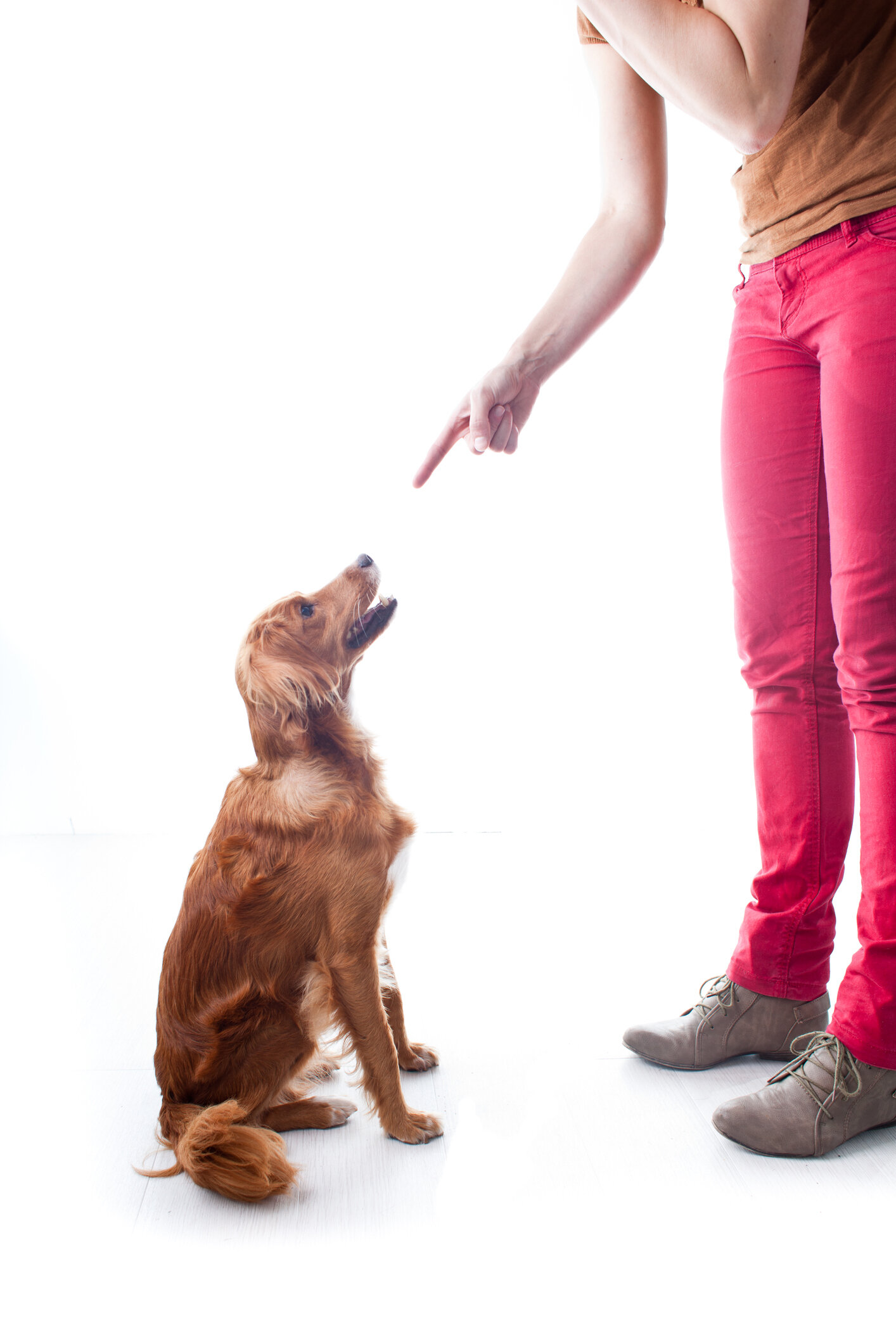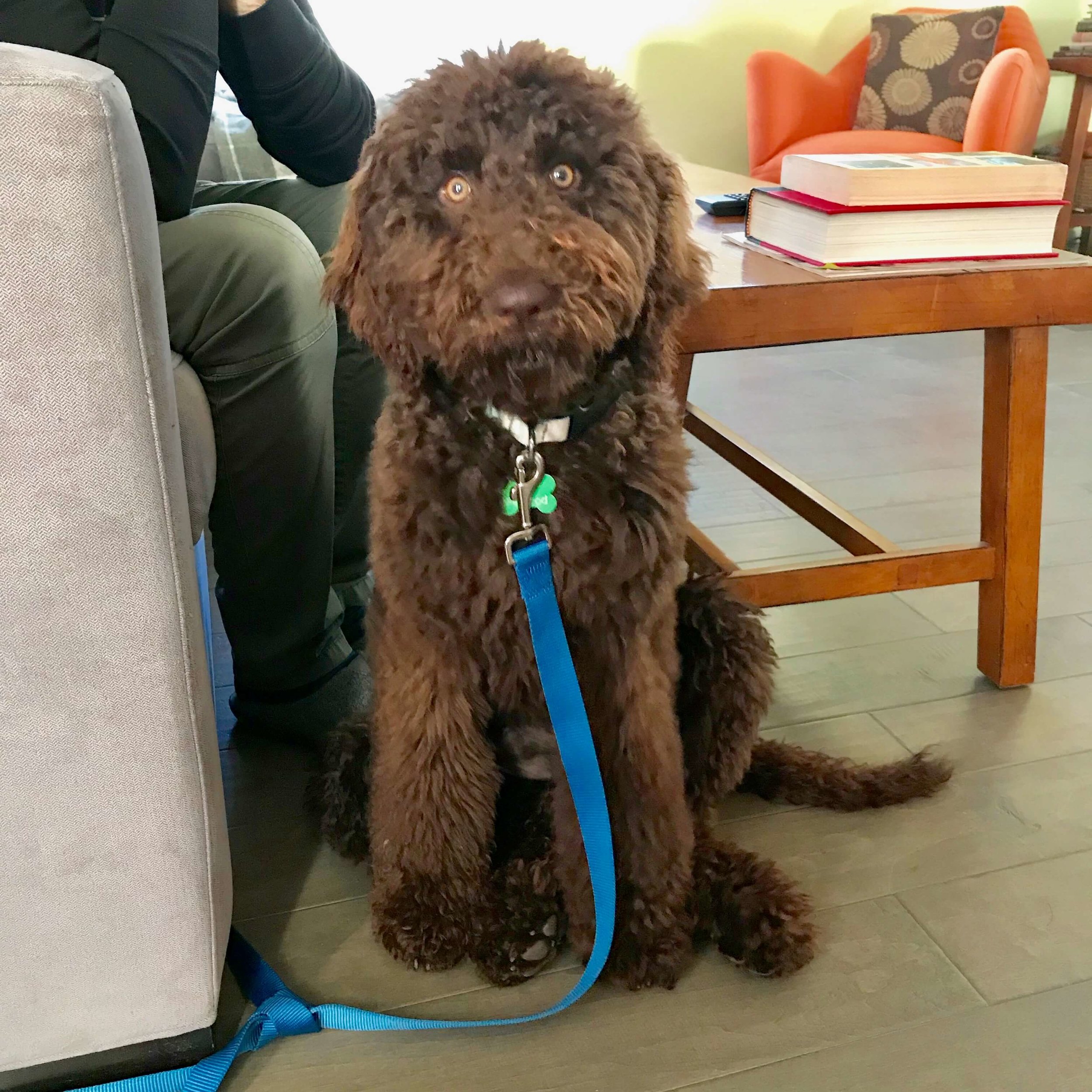How to Stop a Dog from Barking
First, You Must Identify Why a Dog Is Barking
Dogs and puppies bark for a variety of reasons. Barking may express positive feelings of excitement and desire, or negative ones such as boredom, concern, and fear.
It can also be a way for a dog or puppy to communicate with humans about getting their canine needs met, such as when a dog hovers by a door and barks to say, “Please take me outside, I need to go potty!”
And, sometimes—if a dog or puppy cannot stop barking—it indicates that they are over-stimulated, anxious or stressed.
The first step in reducing the amount of barking a dog or puppy does, therefore, is identifying what is prompting them to bark in the first place.
This is because different types of barking require different approaches to training in order to successfully curb the behavior. Let’s examine, then, the different root causes of barking.
Alarm Barking
Alarm barking happens when a dog or puppy hears or notices something in the environment that prompts them to alert their pack to potential danger.
It is the result of natural guarding instincts that all dogs possess and represents a protective impulse to keep the pack safe.
Alarm barking is a respondent behavior, meaning that it is reflexive or emotionally-based, so a dog or puppy does not have control over it when it happens.
However, it is possible to curb alarm barking by changing how a dog or puppy feels about the stimulus that prompted them to bark in the first place, as we will explain shortly.
Demand Barking (or Whining)
Demand barking or whining can also be referred to as an “action-prompting” behavior because it signals that a dog or puppy has discovered that they can get their human guardian to do things for them, if they only just bark or whine long enough.
Demand barking or whining is a conscious behavior that is the result of accidental reinforcement (reinforcement = a reward or pleasant outcome) on the part of the human guardian.
A dog or puppy has learned that, if they bark or whine persistently, their human counterpart will perform a desired action for them (like giving them attention, treats, or access to something they want).
Therefore, this kind of barking needs to be addressed by taking the reinforcement for the behavior away—usually by ignoring a dog or puppy when it happens—until they learn that barking or whining no longer works to get them what they want.
RELATED POST: How To Teach A Dog Or Puppy NOT To Do Something
Over-Stimulated or Anxious Barking
Sometimes, a dog or puppy may get so excited or feel so anxious that they have trouble calming down afterwards.
This is normally the result of being over-stimulated by triggers (triggers = any stimulus that causes a strong reaction) in the environment that cause a dog or puppy to feel a lot of excitement, frustration, or concern.
This kind of over-stimulated or anxious barking may translate into non-stop barking, indicating that the limbic system (limbic system = primal side of the brain) of the dog or puppy’s brain has become over-active, and that they may need some assistance calming down as a result.
This can be achieved with the knowledge of how to induce a dog or puppy to calm down, a process referred to as doggie decompression, which involves restricting your dog’s freedom until they return to a calm state of mind.
Boredom or Distress Vocalizations - Persistent Barking When Left Alone
Persistent, cyclical barking that occurs when a dog is left alone may indicate one of two things: boredom, or worse, canine separation anxiety.
Dogs left in a yard all day or left home alone for long hours with little to no stimulation may fill up their day by barking at whatever stimulus catches their attention.
This type of barking can be solved by bringing a dog inside or providing them with more engagement and regular exercise, perhaps by stopping home at lunch to walk them, or hiring a dog walker to break up the monotony of the dog or puppy’s day (for those who work long hours).
Dog separation anxiety is a different matter, however. This type of barking is usually accompanied by a variety of other stress-induced behaviors like non-stop pacing or drooling, destructiveness, escape attempts, or potty accidents that occur within 20 minutes of a human guardian’s departure.
If you think your dog may have canine separation anxiety, definitely seek out the help of a certified dog trainer who specializes in solving this behavior, because it generally just gets worse. No amount of exercise or crating—the most common, but misinformed recommendations for treating this behavior—will solve the issue.
Different Types of Barking Require Different Methods of Training
Understanding the underlying causes of the array of barking behaviors that a dog or puppy exhibits plays a big part in successfully curbing them. We will do our best to explain the different methods available based on the type of barking that needs to be addressed.
Alarm Barking: Training Your Dog Not to React to Everyday Sights and Sounds
The way a dog guardian responds to alarm barking plays a major role in how a dog or puppy learns to feel about everyday stimuli experienced in the home and neighborhood.
Since alarm barking is rooted in protective instincts, how a guardian reacts to alarm barking will inform their dog or pup how to feel about whatever stimulus has caused them to bark.
It’s up to the human, then, to help their canine distinguish the difference between everyday occurrences (like the neighbors coming and going) and unusual activity (like someone breaking into the house) that they WILL want their dog or puppy to alert them to.
Stay Calm if You Want Your Dog to Respond Calmly
Understanding that a dog guardian is in a position of guiding their dog or puppy how to feel about things that stimulate them to bark is an essential first step towards reducing the amount of barking a dog does.
Unfortunately, the way most people respond to alarm barking is by yelling at or shushing their dog in an angry or annoyed manner, but this just makes the problem worse.
A dog or pup does not know that their barking is what has triggered their human counterpart to get upset, so when their human acts agitated, it only serves to confirm to the dog that there is, indeed, something to get worked up about.
In their mind, their human has joined in on sounding the alarm because potential danger is lurking (and something needs to be done about it!), so more barking ensues.
That’s why it’s really important for a dog guardian to stay calm in these instances— and to, in turn, calm their dog or puppy down when they occur—in order to signal to them that there’s nothing to worry about and, therefore, help the barking to subside.
In this way, a dog or pup learns that a specific stimulus is not a threat, and will eventually stop feeling the need to “alert the pack” to it. This is called habituation, whereby a dog or puppy’s brain starts to register a stimulus as familiar, and no longer feels the need to sound the alarm when they become aware of it.
Using Massage to Calm a Dog Down
When a dog or puppy is alarm barking, the first thing to do is acknowledge that you are aware of what has caused them to bark.
You will then want to massage your dog or puppy to calm them down. Immediately prompting a relaxation response from them is your signal to your dog not to worry about whatever they’ve just seen or heard.
This process facilitates that their brain begins to “reclassify” the stimulus as non-threatening and starts to condition them to accept it.
Using Food To Calm A Dog Down
In some instances, you may also use food to calm your dog down. Food in dog training can be used as a reward, and it can also be used as a counter-conditioner, helping to accelerate the process of turning negative associations into positive ones regarding whatever stimulus is provoking a dog or puppy to bark.
The act of eating also activates the process of digestion, which causes a biological reaction to take place in a dog or puppy’s body that immediately lowers their heart rate, helping to calm them down even further.
Food is most ideal to use when a dog or puppy has a strong, negative association with something, like when the mail person or delivery people come to your door, or when they feel territorial and, consequently, don’t want to let invited guests into the home; otherwise, massage is the first line of defense.
For more information on counter-conditioning, please click here.
Applying a Consequence to Unwanted Barking
Put a dog or puppy behind a gate and stay nearby until they settle down as a consequence for unwanted barking.
Lastly, alarm barking can also be discouraged by applying a negative consequence when it happens.
This would involve removing a dog or puppy from their guarding post—by a window or door where they are barking at people or dogs walking by, or from the yard or patio where they are doing the same from behind a fence—and placing them in a timeout, in order to signal to them that their barking is not appreciated.
When using this tactic, it’s important to act quickly and to place a dog or puppy in a timeout as soon as possible, to let them know that the barking will not be tolerated. Timeouts should be brief and last only as long as it takes for a dog or puppy to calm down before releasing them for another chance to behave correctly.
Demand Barking and Whining: Stop Reinforcing the Behavior by Taking Your Attention Away from Your Dog
Demand barking and whining is a conscious behavior that develops as a result of a dog or puppy discovering that barking and whining will get their guardian’s attention, usually with the goal of coaxing their guardian to do something for them.
Often, a dog or puppy’s human counterpart ends up “caving in” and giving them exactly what they want—whether it’s attention, playtime, a treat, or access to something they desire—just to get their canine friend to stop badgering them, but this only serves to reinforce and perpetuate the behavior.
The trick to stopping this kind of barking and whining, then, is to ignore your dog or puppy when it happens. This can be done by progressively withdrawing your attention away from your dog or puppy by using the following “3 Strikes, You’re Out” rule:
Strike 1: Turn your head to the side in order to withdraw eye contact;
Strike 2: Turn your back to your dog;
Strike 3: Walk away/Leave the room.
If none of these signals work, you may revoke your dog or puppy’s roaming free privileges as a final consequence for unwanted barking. Simply put your dog on a tether, behind a gate, or in a crate until they settle down.
For more on the “3 Strikes, You’re Out” Rule, please refer to our blog post: How To Teach A Dog Or Puppy NOT To Do Something.
Over-Stimulated and Anxious Barking: Using Crates, Gates, and Tethers to Calm a Dog or Puppy Down
If a dog or puppy becomes over-stimulated or stressed by triggers in the environment, the resulting excitement, frustration, or anxiety may prompt them to go into a state of over-arousal—a state of heightened energy also commonly referred to as “going over-threshold.”
When this happens, a biochemical reaction takes place in a dog or puppy’s body, flooding them with too many impulses to process, resulting in obvious and often explosive signs of over-excitement, distress or panic (like non-stop barking, lunging and whining and/or excessive panting, shaking, and pacing), from which they may have difficulty calming down afterwards.
This is a common occurrence if a dog or puppy has strong guarding instincts and does not want to let invited guests into the home, or when a dog or puppy gets over-stimulated by multiple triggers in the environment, like when they go to a family party or bbq for the first time and there’s a lot going on around them.
This type of barking can be addressed by removing a dog or puppy from the situation and placing them on a tether, behind a gate, or in a crate until they calm down. This can be achieved with doggie decompression training, a way of inducing a dog or puppy to calm down using the principle of negative reinforcement.
Boredom or Panic-Related Barking
If your dog barks non-stop when left alone, chances are they are either bored or have separation anxiety.
Bored dogs need more engagement in the form of training or more exercise in the form of walks, hikes, and new adventures.
If they are bored, they need more engagement and exercise. This is when a dog guardian must take it upon themselves to spend more time with their dog, or find professional help in the form of dog walkers or daycare situations to alleviate their dog or puppy’s boredom.
But, if the non-stop barking is accompanied by other symptoms such as pacing, drooling, destructiveness, escape attempts, or potty accidents within 20 minutes of their guardian’s departure, then a dog or puppy is most likely suffering from separation anxiety, which requires professional help to overcome.
For more information on how to solve separation anxiety in dogs, please visit our dog separation anxiety guide.
Barking Can Be Discouraged, but Never Stopped Completely
Knowing how to respond to the different types of barking that a dog or puppy exhibits can go a long way towards reducing the amount of barking they do. However, it’s not possible to eradicate barking altogether - a certain amount of barking is normal and to be expected.
If your dog or puppy barks a lot, try to examine the root cause of the barking and respond accordingly. Alarm barking is an easy fix when a dog guardian makes a commitment to consistently calming their dog or puppy down around common triggers, and demand barking can be solved really quickly, too, by no longer responding to it.
If your dog or puppy’s barking has become a problem, however, and you are at a loss about what to do about it, seeking help from a certified dog trainer—one who uses science-based methodology to solve behavior problems and NOT aversive techniques—is a good idea.
___
Dog training expert, Alexandra Bassett, CPDT-KA, is the owner and lead trainer at Dog Savvy Los Angeles, a Los Angeles dog training company that specializes in positive dog training and solving problem dog behaviors like dog separation anxiety, excessive barking, leash reactivity, and dog aggression.
She is certified as Knowledge Assessed by the Council of Professional Dog Trainers (CPDT-KA) and is available for online dog training sessions via Skype.














